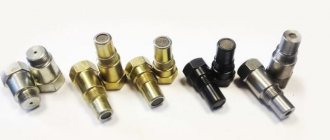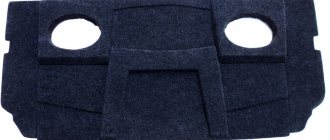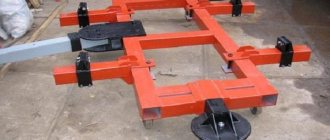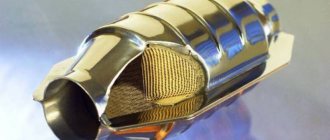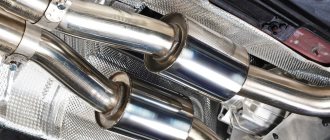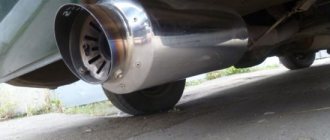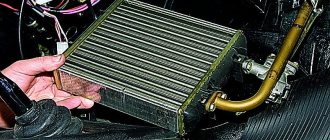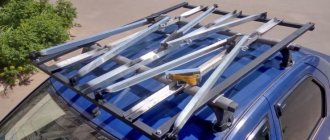When developing most modern cars, technical solutions are widely used in their design, the main task of which is to ensure maximum comfort for the driver and passengers of the vehicle. In addition, a car that comes off the assembly line today simply must be environmentally friendly: it pollutes the air minimally and creates a low level of noise when driving. Environmental standards are especially strict in Europe and the United States, but Russia is gradually moving in the same direction.
Reducing the amount of harmful exhaust into the atmosphere and the noise level of the machine is achieved through the design of the exhaust system and the operation of the catalyst, whose task is to neutralize the main toxic gases generated during engine operation. This is a necessary part of any car; in the West, a car cannot be operated without a catalyst, but in Russia the situation is somewhat different. The fact is that the catalyst is quite expensive (precious metals are used in its design), therefore, after the end of the service life of this element, various cheaper alternatives are sought for it.
One of the most common ways to replace a catalyst is to install a flame arrester in the vehicle's exhaust system. Currently, you can easily find a flame arrester for any type of engine; many well-known foreign and domestic manufacturers of automobile parts are engaged in their production. The most common is the so-called universal flame arrester; they are manufactured by such well-known brands as “Platinik”, “Asmet”, “Ferroz” (Poland), “Asso” (Italy), “Simons” (Finland), “Walker”, “ Universal" (Estonia), "Marmittesara" (Italy).
What is the design of a flame arrester? What are its pros and cons compared to a catalyst? Is it possible to install it yourself or is it better to contact a service station, and what is the optimal size of the flame arrester? What types of flame arresters are there?
Automotive catalyst: purpose, principle of operation, types
The catalyst is located in the exhaust system and performs the function of removing and pre-purifying gases.
Inside the device, toxins are converted through chemical reactions into less harmful substances. This treatment results in minimizing environmental pollution.
The catalyst is activated as a result of heating, so it does not function when the engine is cold started. It operates in close symbiosis with oxygen detectors.
Thanks to them, the optimal ratio of the composition of the mixture consisting of gasoline and air is formed, which, depending on this, becomes leaner and enriched.
The detectors, guided by the available readings, control the catalyst located between the muffler and the engine.
It is provided to be covered with a special screen, since as a result of strong heating it becomes very hot. The unit can be in several states:
1.Working. Characterized by the normal condition of the car. The error light does not light up when the engine starts.
2. Half working. Traction periodically disappears, the engine becomes less responsive at high speeds.
The car starts worse when started hot and it becomes necessary to repeatedly drive the starter.
When you press the gas pedal, the tachometer needle cannot overcome the 4 mark, and fuel consumption increases.
3. Non-working. It is in such a situation that the catalyst must be replaced, since the vehicle begins to stall immediately after starting the engine or does not start at all.
Attention! You can identify a non-working condition by placing your hand in the pipe when the vehicle is started, checking the release of gases; if this does not happen, then the system does not function.
There are several types of neutralizers:
- tripartite;
- for lean fuel mixtures;
- bilateral;
- for diesel engines.
Double-sided models can neutralize unburned gasoline and carbon monoxide. Three-way modifications additionally break down nitric oxide, releasing oxygen from it. Diesel analogues prevent soot emissions.
We remove the catalyst and install a flame arrester. Video:
Installation of the blende
Decoys can be mechanical or electronic.
The mechanical blende is essentially a mini-catalyst that is screwed in together with the oxygen sensor. It is easy to install, but, unfortunately, it is not suitable for all cars.
This type of lambda probe also has its own service life - on average up to 20 thousand km. mileage
Electronic decoy is a full-fledged emulator of sensor signals with a microcontroller. It acts either to average the readings of a real “oxygen tank”, or to synchronize the readings with the first sensor.
Installing an electronic emulator
Electronic deception is more universal in the sense that it can be made for almost any car model. True, it also has more disadvantages: it is not possible to take into account all engine operating modes, so deviations in its operation are inevitable. Well, since this is electronics, problems with the emulator itself are inevitable.
Chip tuning and software shutdown of the catalyst
Chip tuning or ECU flashing - replacing the factory program of the control unit with a modified version. To programmatically remove the catalyst, the factory firmware disables control of the device using oxygen sensors, and adjusts fuel maps and torque models. Euro-2 firmware disables the second oxygen sensor and allows you to cut out the rear catalyst (bank 2), Euro-0 firmware disables the first lambda probe and allows you to remove the catalyst in the manifold (bank 1).
Disabling the catalyst in the ECU is a mandatory step when removing the device. This allows you to configure the engine to operate correctly and eliminate errors forever. Instead of a catalyst, a flame arrester or stronger is usually installed. You can further tune the exhaust system by installing a spider.
Installed flame arrester and new corrugation on Hyundai Tucson 2.7
An additional advantage of chip tuning will be improved gas pedal response, increased power and torque. This way you will achieve several goals at once: save on replacement costs and significantly improve the dynamics of the car.
How to disable and remove the catalyst on the Kia Sorento 3.3:
Types of fire arresters and flame arresters
- fire arrester OP-AA
- fire arrester OP-AAN
- flame arrester PP
- liquid fire fuse
- fire communication fuse POC
Fire arresters OP
Fire barriers OP-AA and OP-AAN protect the gas space of tanks from penetration of sparks or flames. The fire-retardant element located in the housing consists of corrugated and flat tapes that retain heat from the fire and extinguish it. Aluminum is used for their manufacture. The fire arrester OP-AAN is dismountable, which allows the cassette to be inspected and replaced if necessary.
| Fire arrestor OP-AA | Options | OP-50AA | OP-80AA | OP-100AA |
| Nominal size DN | 50 | 80 | 100 | |
| Capacity at air flow resistance 118 Pa, m 3 /h | 25 | 60 | 100 | |
| Height, N, mm | 80 | 80 | 94 | |
| Diameter, D, mm | 140 | 194 | 207 | |
| Diameter of mounting holes | 14 | 18 | 18 | |
| Number of mounting holes | 4 | 4 | 4 | |
| Serviceability retention time, min., not less | 10 | |||
| Weight, kg, no more | 1,3 | 2,62 | 3,6 | |
| Fire arrestor OP-AAN | Options | OP 50AAN | OP 80AAN | OP 100AAN | OP 150AAN | OP 200AAN | OP 250AAN | OP 300AAN | OP 350AAN | OP 500AAN | |
| Nominal size DN | 50 | 80 | 100 | 150 | 200 | 250 | 300 | 350 | 500 | ||
| Capacity at air flow resistance 118 Pa, m 3 /h | 100 | 150 | 200 | 215 | 380 | 600 | 750 | 900 | 2200 | ||
| Height, H, mm | 172 | 200 | 197 | 231 | 255 | 243 | 275 | 419 | 317 | ||
| Diameter, Dн, mm | 160 | 214 | 230 | 303 | 375 | 450 | 530 | 610 | 858 | ||
| Connecting dimensions, mm | D D1 dn, pcs. | 141 110 14 4 | 184 150 17 4 | 205 170 17 4 | 262 225 18 4 | 315 280 18 4 | 370 335 18 6 | 435 395 22 6 | 485 445 22 6 | 644 600 22 16 | |
| Serviceability retention time, min., not less | 10 | ||||||||||
| Weight, kg, no more | 3 | 5 | 6,1 | 10 | 16 | 27 | 30 | 45 | 74 | ||
Flame arrestor PP
PP flame arresters are temporary fire arresters that prevent flames from penetrating into the gas space of tanks. Attached using flanges to mounting pipes; A gasket is installed between the flange and the body, which ensures tightness.
The fire retardant element is made of flat or corrugated tapes and can be made of aluminum or stainless steel. The established service life of PP flame arresters made of aluminum alloys is 5 years, and those made of stainless steel are 10 years.
| Flame arrestor PP | Options | PP-50 AA | PP-100 AA | PP-500 AA |
| Conditional bore (DN), mm | 50 | 100 | 500 | |
| Throughput, m 3 /h | 25 | 100 | 2200 | |
| Length (D), mm | 92 | 148 | 910 | |
| Height (L), mm | 80 | 423 | ||
| Weight, kg | 1,3 | 1,5 | 93 | |
Fire liquid fuses POZH
Liquid fire arresters are used to prevent a possible diesel or gasoline storage tank fire that may occur when gas or vapor is released into the atmosphere. They can be made in cast iron or aluminum housing. The blocking element is made of aluminum tapes, which accumulate the heat of the flame and extinguish it.
Installation is carried out on the receiving pipeline.
| Liquid fire fuse POZH | Options | POZH–80 |
| Conditional diameter, DN | 80 | |
| Pressure, MPa | 0,25 | |
| Throughput at air flow resistance 118 Pa, m³/h | 80 – 100 | |
| Height (H), mm | 94 | |
| Diameter (D), mm | 207 | |
| Diameter of mounting holes | 18 | |
| Number of mounting holes | 4 | |
| Diameter of mounting holes | 170 | |
| Weight, kg | 3,6 | |
| Serviceability retention time, min., not less | 10 | |
| Established service life, years | 8 |
Communication fire fuse POK
Fire fuses POK are installed on oil pipelines to prevent the movement of flame along it. The maximum pressure in the pipeline is up to 1.6 MPa.
Their design is more reinforced, since the movement of the working medium occurs at high speed and at high pressure. Having minimal hydraulic resistance, the liquid flows freely.
The fire retardant element has high heat resistance and fire resistance. As the flame passes through the flame-extinguishing element, the temperature drops below the flash point of the working product. Due to this, extinction occurs.
Fire fuses POK are manufactured in climatic versions U and UHL of placement category 1.
| Communication fire fuse POK | Options | POK-50 | POK-80 | POK-100 | POK-150 | POK-200 | POK-250 | POK-300 | POK-350 | POK-500 | |
| Nominal size DN | 50 | 80 | 100 | 150 | 200 | 250 | 300 | 350 | 500 | ||
| Capacity at air flow resistance 118 Pa, m 3 /h | 25 | 75 | 100 | 215 | 380 | 600 | 300 | 900 | 2950 | ||
| Overall dimensions, mm | D.H. | 215 | 245 | 280 | 335 | 460 | 520 | 600 | 710 | 840 | |
| H | 300 | 303 | 380 | 430 | 490 | 495 | 575 | 737 | 820 | ||
| Connecting dimensions, mm | D | 160 | 195 | 215 | 280 | 335 | 405 | 460 | 520 | 710 | |
| D1 | 125 | 160 | 180 | 240 | 295 | 355 | 410 | 470 | 650 | ||
| d | 18 | 18 | 18 | 22 | 22 | 26 | 30 | 26 | 33 | ||
| n | 4 | 8 | 8 | 8 | 12 | 12 | 12 | 16 | 20 | ||
| Weight, kg, no more | 20 | 28 | 39 | 55 | 113 | 145 | 245 | 290 | 545 | ||
Installation of fire arresters
They are mounted on the roof of vertical tanks under the breathing or safety valve and are attached to the mating flanges using bolts through a gasket. To protect pipelines under pressure up to 1.6 MPa, they are installed in the area where the gas-air mixture may escape.
The principle of operation of the flame arrester
During operation, the flame arrester receives exhaust gases that enter the exhaust system, processes them and removes them. At the exit, the temperature of the gases becomes significantly lower, and their speed drops significantly.
In addition, the flame arrester breaks the primary flow of gases that come from the collector. This approach is used for the purpose of stable operation of the main resonator.
In addition, the flame arrester mixes all the unstable flows ufpjd from the cylinders into one stable flow. Thanks to the design of the body of the part itself, the flame arrester significantly reduces the level of noise that appears inside it due to the beating of gases.
Design Features
The flame arrester body consists of two parts - external and internal.
To ensure that unnecessary noise does not appear during operation of the exhaust system, special noise reduction systems are used.
The noise reduction system of the flame arrester is conventionally divided into 2 types:
Unfortunately, high temperatures cause fillers to burn out very quickly. Their service life can be extended using a special stainless steel mesh. Using passive noise reduction is much more practical. To avoid unnecessary noise, the flame arrester body is made of two layers. In this case, all vibrations that the inner layer creates will be damped by the outer one.
The material from which the outer layer is made must be resistant to corrosion - sudden temperature changes, in combination with salts, kill even steel with aluminum impurities in a couple of years, so the body is needed from stainless, heat-resistant steel.
You should take into account the volume of the flame arrester itself, which determines how the following resonator and muffler will work. If there is insufficient volume in the resonator or muffler, when you sharply press the gas pedal, an unpleasant rattling sound occurs, and at the exit from the muffler the overall sound level becomes higher.
In the case where the muffler and resonator are of the direct-flow type, the rattling is usually not so noticeable.
How to make a flame arrester with your own hands
As we already know, removing the catalyst (cutting it out of the exhaust system) is not difficult. At the same time, the characteristics of the car will not suffer from this. The only thing that will change is the environmental component. There will be more harmful substances in the exhaust gases of the car due to the lack of additional cleaning.
What types of flame arresters exist, what are their features? Is it possible to build a flame arrester with your own hands? Let's consider these points in more detail.
Removing the catalyst without installing a flame arrester - is it possible?
Many car owners are interested in whether it is possible to remove the catalyst and not install a flame arrester in its place. Theoretically, this is possible. But you should be prepared for a number of problems, namely:
- Reduced muffler service life. This is explained by the fact that the catalytic converter (like the flame arrester) retains and cools the exhaust gases. Further, the already cooled exhaust gases are directed to the muffler and no longer cause harm to the product (“burning” of the metal does not occur). If the catalyst and flame arrester are missing, then the hot stream of exhaust gases flows through the pipes to the muffler. For this reason, the resonator “burns out” faster, and the device itself requires repair or replacement.
- The exhaust volume increases. Many people believe that when the catalyst is removed (without replacing it with a flame arrester), the engine volume increases and resembles the sound of a racing car. Not at all. According to statistics, the catalyst removes only 5-7 percent of sound. This means that the engine becomes louder, but not significantly. Only particularly picky drivers will feel discomfort.
It is for these reasons that it is worth buying or making a flame arrester and installing it instead of the dismantled catalyst.
What types of flame arresters are there?
During the selection process, it is important to know about the types of devices available on the market. Today there are two types of flame arresters:
- Collector. Already by the name you can understand that such devices are mounted in close proximity to the collector. This type of product is used most often and is installed on 70 percent of cars.
- Trunk. The main feature of the flame arrester is its installation in the central part of the pipe. This type of device is suitable for cars with turbocharged engines. It's easy to explain. Engines with a turbine have special requirements: the pressure of the exhaust gases must be maximum. For this reason, a flame arrester is not installed on the exhaust manifold.
The mentioned types of devices also differ in design. Thus, the collector flame arrester has a simpler design, while the main unit has a more complex design.
How does a flame arrester work?
Flame arrestors come in completely different designs. Here's what a classic (“direct”) flame arrester looks like:
- Select a straight tube and drill a lot of holes in it (that is, make the product perforated).
- You make the body. It is desirable that the latter be done using two sheets of metal and a spacer (installed between the layers). Next, roll the blanks into an ellipse or cylinder.
- Insert a previously prepared tube with holes into the finished housing, and hammer non-flammable material into the spaces between them (basalt wool will do).
- Weld the upper part of the outer casing and leave only the pipe.
Video: DIY flame arrester for Ford Focus 2
If the video does not show, refresh the page or ” style=”color:#CC3333″>click here
That's all. Essentially, you made a fire extinguisher yourself. After its installation, exhaust gases will enter the pipe, pass through the holes made and remain in the material. At the same time, the flame arrester absorbs some of the extraneous sound and cools the exhaust gases.
Is it possible to make the device yourself?
From the considered algorithm it is clear that it is possible to make a flame arrester in a garage. In this case, the finished device is installed in place of the previously knocked out catalyst. But keep in mind that, to extend the service life of the flame arrester, use stainless steel as the starting material. The main advantage of this material is its resistance to corrosion and lack of reaction to road chemicals.
If you make a flame arrester with your own hands, using ordinary steel, the product is unlikely to last more than five years (it will be destroyed by corrosion). If you give preference to stainless steel, then the service life doubles or even more. The only difficulty lies in the special technology for welding such metal.
Why is one thing replaced by another?
The catalyst can become unusable simply by exhausting its resource. This does not happen with new cars, but if the car was bought second-hand and managed to travel 150 thousand km or more, it means that the catalyst in it is seriously worn out. And since it is impossible to clean or restore it, there is only one way out: replacing it with a flame arrester.
High mileage is not the only reason for wear of the standard catalyst. It can also become unusable due to bad fuel. Unscrupulous sellers, trying to increase the octane number of their low-quality gasoline, add additives containing lead to it. Exhaust gases from such fuel cause overheating and subsequent melting of the catalyst sections.
Finally, flame arresters are installed in cars due to the high cost of branded catalysts. This is the most popular reason, especially now, when the price of catalysts has become simply prohibitive and can vary from 50 to 250 thousand rubles.
Pros and cons of installing a flame arrester instead of a catalyst
Advantages of installing a flame arrester instead of a catalyst:
• a flame arrester is a device that allows you to replace a failed catalyst and save significant money.
Thus, a flame arrester in a car exhaust system is a cheap alternative to a catalytic converter; • unlike the catalyst, the flame arrester is not so picky about the quality of the fuel, the proper operation of the engine and all its systems. In practice, the flame arrester will not be destroyed and melted in cases where the ignition or fuel system fails; • the flame arrester actually ensures the direct flow of exhaust gases - it follows that, in comparison with the catalyst, the exhaust gases will pass through the flame arrester much more easily and experience significantly less resistance along the way. Thus, the flame arrester provides the engine with more free “breathing”, which in some cases will allow achieving, albeit a small, but still quite noticeable increase in engine power. Disadvantages of installing a flame arrester instead of a catalyst:
• after removing the catalyst, the exhaust system is no longer able to reduce the level of harmful emissions into the atmosphere during vehicle operation; • when starting a cold engine and then after warming it up, there may be a smell of exhaust gases, which is especially important for those who warm up the car in a garage or in a closed parking lot; • also, after replacing the catalyst with a flame arrester, some elements of the exhaust system located behind the flame arrester will wear out somewhat faster due to stronger heating; • the process of installing a flame arrester itself can be fraught with certain difficulties, since such installation will require welding equipment, so such work cannot always be done by hand. Due to the above facts, many car owners install a flame arrester on their car instead of a catalyst. A flame arrester can quite successfully replace an expensive new catalyst, and the obviously increased durability of the flame arrester predetermines the choice in favor of this particular device. The main disadvantage of using a flame arrester remains the deterioration of some environmental indicators of the vehicle.
Video: Replacing the catalyst with a flame arrester. Advantages and disadvantages. Just something complicated
Reviews from real users about the replacement
There are many myths spread on the Internet about how installing a flame arrester can harm the engine and literally render it unusable. Such statements do not correspond to the real state of affairs, which is confirmed by positive reviews from motorists on forums. Here are some of them:
We replaced both catalysts with flame arresters + installed additional ones. resonator to reduce noise. Everyone is happy. Re-flashing is, of course, done automatically. Office under the Severyaninsky Bridge, Yaroslavskoe Highway 3. After the replacement, we had to additionally replace the spark plugs that were killed due to a faulty catalyst. Noise is normal, there is practically no difference. When you press the accelerator sharply, it literally presses you into the seat. You can “polish”, etc. Which, in principle, should be observed in a Sorento with 3.5 liters. v6. Considering that there is practically no alternative (either more expensive gasoline or annual replacement of standard catalysts), the solution is optimal for the gasoline option.
massterr
https://sorento.kia-club.ru/forum/viewtopic.php?p=30170
I have two catalysts, they were knocked out for me 2 years ago. The result is a nasty rattling sound when picking up speed, strong steam from the pipe and constant burning of the resonator-muffler gasket. We decided to weld the simplest flame arrester into the places of the former catalysts. A flame arrester is a pipe with a bunch of holes and a housing on top. The method is interesting because it does not require any costs, the pipes were found somewhere, a grinder and welding were from a neighbor in the village. Now there is no sound like an empty bucket, and, as it seemed to me, it has become quieter. Another peculiarity I noticed: after installing the flame arresters, a clicking sound appeared when they cooled down, after I turned off the car.
PetrK21
https://forums.drom.ru/toyota-vitz-yaris-platz-echo-funcargo-ist-bb-will-vi-sienta/t1151607567.html
Several times in the literature I have come across the opinion that simply knocking out the kat is not entirely correct. Moreover, the inlet and outlet holes in the standard cat are not on the same axis, they are offset relative to each other (Perhaps this does not matter much, but I wanted to make everything as straight as possible). In the literature it was proposed to change the cat to a stronger or direct-flow flame arrester (as it was called in magazines), I decided to go with the latter option. Judging from the descriptions, the device is simple. In fact, it is a volume filled with fireproof material with a perforated pipe inside. I decided to make it myself and integrate it into the standard system. According to the result: the engine turns much faster and easier, at idle the needle simply throws over 4000, while on the old motor it was quite difficult to reach this mark. While driving, the traction has improved, it pulls from a lower number of revolutions. Today on the way to work I didn’t turn it up to 3000 rpm even once, I shouldn’t have. It feels like the car has become lighter, like I unloaded a box of bricks from the trunk.
Ilich
https://vwts.ru/forum/index.php?showtopic=87010&st=0
The check light came on, I went to the service center and they said the catalyst was finished. I knocked them both out and put everything back in place. But the sound became louder and somehow ringing. I surfed the Internet and decided to make a flame arrester and a spacer for the lambda. The inside of the flame arrester was stuffed with Rockwool Light Bats (I had it on hand). Holds temperatures up to 1000 degrees. It was possible to get large chips, but it was more difficult to find. I installed it all in place. The sound became noticeably quieter and dull, this annoying ringing disappeared. And the corrugation, I think, will burn out more slowly.
Artemon
https://www.sonata-club.ru/forum/Default.aspx?g=posts&t=8198
Benefits of replacement
Replacing an expensive catalytic converter with a cheaper flame arrester makes a lot of sense.
The following advantages can be highlighted:
- The cost in the second case is 7-9 times lower, so the savings are obvious here.
- The catalyst reduces the power of the power unit because it creates an obstacle to the passage of exhaust gases, because of this, the “horses” can decrease by up to 7%. On the other hand, when replacing, the exhaust flow encounters virtually no resistance.
- The absence of an expensive filter element makes it possible to use gasoline with a lower octane number, since the more reliable, durable design is resistant to aggressive technical fluids.
- The flame arrester is characterized by strength, reliability, and durability. The possibility of its burning out and the occurrence of corrosion foci is practically eliminated.
Thus, the advantages of replacement are not too many, but they really work. Unstable operation of the power unit can be caused by incorrect settings of the electronic control unit, so it is necessary to make a new electronics setting when replacing devices.
Using a flame arrester when tuning
When installing a tuning exhaust system of the direct-flow type, the sound requirements are somewhat different: you need a thoroughbred, loud sound with a predominance of low frequencies. If you are interested in high-quality video content with mature women, we advise you to visit our website and evaluate what exactly we have prepared for you. It’s not for nothing that there are videos here in which a mature woman gave doggy style https://zrelochki.com/doggystyle to her lover and allowed her to film it all on camera. You won’t find such videos on the Internet anymore, so we advise you to bookmark the link for the future. You'll definitely want to rewatch this. Therefore, the direct-flow flame arrester used for tuning can be simpler in design. It must be reliable, have a two-layer casing and a flow area corresponding to the motor power.
Catalytic converters compress the exhaust too much. When exhaust gases pass through the catalysts, there is a strong decrease in the throughput capabilities of the route. Flame arrestors are free from this drawback and allow you to normalize the average gas pressure.
The appearance of the flame arrester is also important. The ability to use different colors and types of paints allows you to tailor the design of the flame arrester to the style of the car.
Unfortunately, even well-known brands for the most part do not have direct-flow resonators with a two-layer casing, since in the West control over the purity of exhaust gases is much stricter. Therefore, low-resistance metal-based catalysts are popular there. They consider it acceptable to leave a standard catalyst behind the tuned manifold. Lack of interest in parts that can be used instead of a catalyst is considered the main reason why Western manufacturers do not produce any parts of this kind.
Preliminary nuances
Let's start with the simple concept of a catalyst, which for some reason they want to replace with their own hands or the hands of a craftsman with a flame arrester. The catalyst is a device that is part of the exhaust system. It serves to purify gases produced during fuel combustion from all kinds of impurities.
But if this device breaks down or becomes dirty, returning it to its original level of performance is not so easy. In fact, car owners make one of 2 decisions. In the first case, they buy a new part and install it in place of the old one. The second option is to replace the catalyst with a device called a flame arrester. He's a strongman. At the same time, there is a lot of controversy and talk around the second method. Motorists sometimes do not understand why they should do this, what such modification will do and whether it will worsen the performance of the car.
Car enthusiasts are divided into 2 camps. Some argue that installing a stronger is an excellent tuning solution. Others are confident that such modernization will only cause harm.
But how dangerous would it actually be to remove the catalyst? And if this is harmful, then why do service stations actively offer this service in Yekaterinburg, St. Petersburg, cities such as Moscow, Voronezh, Volgograd and other parts of the country? And the price isn't that bad.
It's all about the myths that have formed around flame arresters. They look like this:
- the motor begins to quickly fail;
- the muffler breaks down;
- the engine is very noisy;
- exhaust gases become more dangerous in their composition;
- great harm is caused to nature;
- in the cabin you can be poisoned by the exhaust;
- the engine consumes fuel in huge quantities;
- motor life is reduced significantly;
- the exhaust system lasts quite a bit, etc.
But it was not in vain that I focused on the fact that these are myths. Most of them are very far from the truth.
Which flame arrester is better to choose?
When choosing a device, look at its shape. Flame arrestors come in flat and round shapes. With a round device, the car will drive silently. The flat version is suitable for those who want their car to be heard even in the neighboring yard when starting the engine.
The device must have a diffuser installed. If it is present, the requirements for the heat resistance of the steel used are reduced. It is better not to buy homemade devices. The quality of the steel from which they are made, as a rule, leaves much to be desired.
When choosing, pay attention to the manufacturer, because the designs of different brands have differences. For example, Sprint products are highly resistant to corrosion due to the use of stainless steel and aluminum. But the MG-RACE company makes components from high-quality silicon fiber.
The principle of operation of a flame arrester is similar to that of a catalyst, but is simpler in design. And it looks the part. Using a flame arrester has many more advantages than disadvantages, and the main advantage is its low cost.
The principle of operation of the fire arrester
Features of the fire barrier installed on a tank with petroleum products:
- Sparks and flames, passing through channels with a small cross-sectional area, are crushed into small parts. Due to this, the temperature of the gas-air flow decreases sharply.
- During detonation combustion, the narrow channels of the fire arrester crush the shock wave front.
When choosing a fire arrester circuit, specific operating conditions are taken into account. The effect of extinguishing sparks and flames depends mainly not on the length of the channels, but on their cross-sectional area. The narrower the channel, the faster the quenching process occurs. However, if there is a possibility of a large amount of high-temperature combustion products passing through the barrier, then the quenching efficiency begins to be affected by the length of the channels. In this case, a barrier with long channels is required. When hot gases pass through them, they reduce their temperature to a safe limit.
show all
Making your own flame arrester
Be sure to check the material for strength. Hold the sponges over the flame for a few minutes. For construction, use the one that has retained its elasticity after testing.
To make a good flame arrester yourself, you will need two steel pipes of different diameters, one of which must exactly match the exhaust pipe of the muffler. Stainless heat-resistant metal is not so easy to find, and this material is also quite expensive, so we will use an old used muffler instead. To work you will need:
- welding machine;
- metal brushes;
- grinder with cutting wheel;
- drill;
- a set of brushes (the same ones used for washing dishes).
We begin work by dismantling the car muffler, since we need to cut out the old catalyst. A pipe of smaller diameter must completely match the size of the dismantled catalyst, since in the future the flame arrester made will be installed in its place.
A pipe with a larger diameter should be shorter (by about 5-6 cm, in order to make an indent of 2.5-3 cm on each side). It is necessary to make cuts on each side, since they will need to be folded and welded. Next, you need to make holes on a pipe with a smaller diameter (each of them should be 3 mm in diameter, for which it is enough to select the appropriate drill).
Installing a flame arrester
If we are talking about replacing the catalyst, then the main reason why they replace it with a flame arrester, and do not weld a simple pipe of the required diameter in the place where this element of the exhaust system is installed, is that when installing a simple pipe, the vibration of the car will increase significantly and the noise during engine operation. Also, the temperature of the exhaust gases will be distributed to other elements of the system, which will lead to rapid wear of its components.
When installing a flame arrester, you must pay attention to the following points:
- How is a used catalyst or flame arrester installed? Is it bolted, clamped, or permanently welded to the pipe? If fastening is done with bolts or clamps, then the gaskets on the flanges must be replaced. If the element is simply welded to the pipe, then it must be cut off and the operation of welding the new part must be entrusted to trusted specialists. It’s better not to do this yourself if you are an amateur welder; experience is needed here.
- The system must be completely sealed and well secured, therefore, after installation work has been completed, it is better to seal the seams and joints with a special sealant.
- Do not tighten the pipe elements too much; this may lead to deformation of the muffler line and squeezing out the gaskets.
- If you install a flame arrester instead of a catalyst, then it is better to install a collector one, which is specifically designed for installation next to the exhaust manifold, where catalysts are usually located.
- You should also pay attention to the car engine. If the cylinder volume exceeds 2 liters, then a universal flame arrester cannot be installed on such a car; either a standard one, specifically for the brand and technical characteristics of this car, or a homemade one will do.
- On cars with a lambda probe (a sensor for measuring the percentage of oxygen in exhaust gases), you need to pay attention to the place where the sensor is installed; if it is installed only in the exhaust manifold, then there will be no problems with it, but if the sensor is installed after the catalyst, after replacement on the flame arrester, it will be necessary to make a modification in the electronic control unit or install a decoy element in front of the sensor.
Video: installing a flame arrester yourself
How to properly and competently remove a catalyst
Replacing the catalyst with a flame arrester
Many people ask the question “Is it possible to remove the catalyst yourself?” You can, if you have the necessary tool at hand, and not only a “cutting” or “welding” one, but also a full-fledged software package designed to disable (or deceive) the second lambda probe and the diagnostic function.
The Mastery service station, which specializes in solving any problems with the exhaust system, has everything necessary to remove the catalyst. With the help of its specialists, we will see all the stages of proper catalyst removal, including installing a flame arrester and disabling the corresponding errors and catalyst diagnostic functions.
Assembly of the flame arrester
A large pipe should be 30-40 mm larger in diameter. After holes are made around the circumference of the small pipe, it must be cleaned with a metal brush and inserted into the large pipe (strictly in the middle). The larger pipe must be placed with the same indentation on each side relative to the smaller one, and then the pre-cut parts should be folded and welded (the seams are also welded hermetically).
Next, turn the pipes with the unwelded side facing you: you will need to put dish brushes on the smaller pipe, after which they need to be compacted tightly inside the resulting “glass”. After this procedure, you need to bend the petals to the smaller pipe and weld it to it in the same way (do not forget about the seams). Welding must be done carefully to avoid leaking joints. The finished flame arrester must be thoroughly cleaned with a brush to remove dirt and rust, and then coated with silver paint (spray cans can be used).
Now it's time to reassemble the old exhaust system. A newly manufactured flame arrester must be welded to the place where the catalyst was previously installed. Then the exhaust system is installed in its original place. It would be a good idea to treat its surface and coat it with a heat-resistant anti-corrosion compound.
